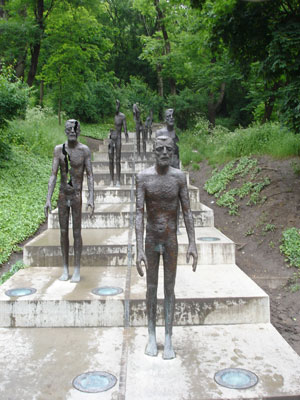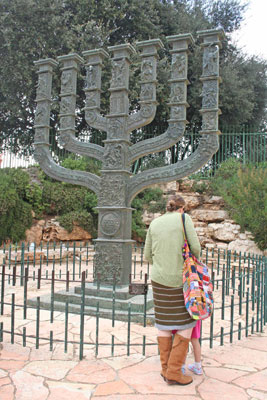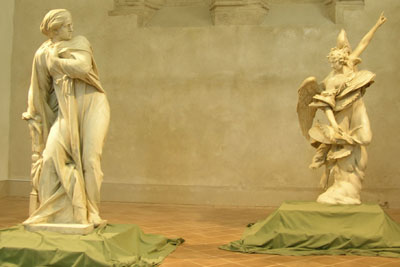Captivating art
In the course of your travels outside of the US, what work of art took you by surprise in that it affected you deeply in some way? Which one lingered in your memory for some reason or made you long to see it again? Subscribers’ responses to those questions were printed in the July and August 2011 issues, and we’re printing the last batch of them below.
If you were moved by a painting, sculpture or other visual work of an artist (excluding great architecture — no buildings, themselves), write to Captivating Art, c/o ITN, 2116 28th St., Sacramento, CA 95818, or e-mail editor@intltravelnews.com. (Include the address at which you receive ITN.) Photos are always welcome; include captions.
When I was a child of seven or eight, my mother took me to a visiting exhibition of the art of Vincent van Gogh in Seattle. We were able to see many memorable works that day — colorful sunflowers, people working in the fields, etc. — but the one canvas that remained in my memory was “The Potato Eaters.”
As I stood before that painting, I was drawn into it by the darkness and the gnarled people looking so much like the potatoes they dug that kept them alive. It seemed as if I could smell the sweat and the dirt.
Those people gathered around that table became etched in my mind, and the struggle of life just to survive made an impression that has stayed with me to this day. What a gift to be able to see the wonderful pieces in that show!
“The Potato Eaters” is now part of the collection at the Van Gogh Museum (Paulus Potterstraat 7, AMSTERDAM, Netherlands; phone +31 [0] 20 570 5200).
Janna Palm
Bellingham, WA
My husband, Bob, and I and our friends Herb and Claire spent a few days in PRAGUE, Czech Republic, in May ’08. One day we decided to get away from the tourists and just go where our feet took us. Eventually, we found ourselves at the base of Petrín Hill on Ùjezd Street. There we discovered the very moving and very sad Memorial to the Victims of Communism.
This work by sculptor Olbram Zoubek and architects Jan Kerel and Zdenĕk Holzel is dedicated to the victims of the Communist era. A series of figures of a man stands on ascending steps. The first figure shows the man whole, and successive statues show his gradual destruction. By the last, only a small part of him remains.
The plaque nearby reads, “The memorial to the victims of Communism is dedicated to all victims, not only those who were jailed or executed but also those whose lives were ruined by totalitarian despotism.”
During the years 1948-1989, thousands in the former Czechoslovakia were jailed. Many died in prison and many more were executed. Thousands emigrated to other countries. This memorial makes a very powerful statement in a country that does not plan to forget its past.
Nancy Gatland
Wilton, NY
Trying to select one memorable piece of art is an impossible task, but I’ve thought of three that I feel privileged to have seen, each of which always bring back the memory of the first time I saw it.
In the part of Italy where the Etruscans lived and ruled is the small city of TARQUINIA, and housed in the Palazzo Vitelleschi is the Museo Nazionale Tarquiniese (Piazza Cavour, Tarquinia; phone 06 399 67 150). On the first floor of the museum is a magnificent Etruscan frieze of two winged horses. Although it was the late 1970s when I saw it, I still ponder the ability of these ancient people to create such a work.
In France, the stained-glass windows of CHARTRES Cathedral are so beautiful. On a bright day, the abundance of blue glass in the 13th-century windows fills the cathedral with a glowing light. The windows also have stories to teach us, as they did for people in the Middle ages. I have seen the windows four times over the years and each time have felt spiritually enriched.
Rembrandt is one of my favorites, and his painting “The Jewish Bride,” also called “Isaac and Rebecca,” at the Rijksmuseum AMSTERDAM (Postbus 74888, 1070 DN Amsterdam, Netherlands; phone +31 [0] 20 6747000), is one of the loveliest paintings I’ve ever seen.
Rembrandt’s ability to show the emotions of his subjects is a mark of his genius. One can feel the love and devotion of the couple in the painting. I saw it in the 1970s and it made an indelible impression on me.
Elaine Birtch
Springfield, IL
The town of VOLTERRA, Italy, has two small Etruscan museums, and in the Etruscan Guarnacci Museum (Via Don Minzoni 15, 56048 Volterra [PI], Italy; phone +39 0588 86347) the prize piece is “Ombra delle Sera” (“Shadow of the Evening”); I’ve also seen it referred to as “L’Homme de la Terre” (“Man of the Earth”).
About the length of a small golf club, it is a slender metal sculpture of a young boy. He is smiling, curly haired and captivating.
The work was discovered by a farmer who plowed it up in his field. He felt it would make a great fireplace poker, so that is what it would be doing to this day if it weren’t for fate. Fortunately, an Etruscan scholar visited the farmer and identified what he saw.
I loved the piece so much when I saw it on a visit to Italy 10 years ago that I visited every jeweler in Volterra to see if I could get a replica in pendant form. In a small basement jewelry shop, the proprietor said he had made one in 18-karat gold for his wife, and if she could find it he would sell it to me. I paid $350 for it, but to me it is priceless. It is my favorite to this day.
Dee Hornback
Los Altos, CA
My husband and I have visited 49 countries and have been inspired, awed and captivated by wondrous works of art created by both famous and not-so-famous artists. Bernini’s angels on the Ponte Sant’Angelo in ROME and the Monument to the Ghetto Heroes in WARSAW are two examples of works not confined to a museum but meaningful, nevertheless. However, one memorial reduced us to tears when we happened upon it on our second visit to BUDAPEST, Hungary, in April ’09.
“Shoes on the Danube Promenade” (located on the Pest side of the promenade, between Roosevelt Square and Kossuth Square) honors the victims of the Arrow Cross militiamen. This was a group of Nazi sympathizers who, in 1944 and ’45, rounded up Jews, lined them up on the promenade and shot them, their bodies falling into the Danube.
The memorial consists of 60 pairs of iron shoes on the stone embankment plus a 40-meter-long stone bench and several plaques telling the story of the events of 1944-45. The shoes are a lifelike reminder of what the people of Hungary endured during the war. Truly moving and worth a visit!
Barbara Pry
Ringwood, NJ
The Knesset Menorah by Benno Elkan, located across the road from the Israeli Knesset (Parliament) building in JERUSALEM, is a 15-foot-tall bronze monument that had a great impact on me when I saw it on a tour of Israel and Jordan in May ’11.
Traveling throughout Israel, including the Golan Heights and the West Bank, our group interacted with Israelis, Palestinians, Druze, Bedouins, Orthodox Jews, members of the military and kibbutzniks. Our visit to the Knesset Menorah came toward the end of the tour. We were the only tourists at the site, but a steady stream of Israelis visited while we were there.
The menorah is the symbol of the State of Israel, and the Knesset Menorah has scenes carved on it depicting Jewish history. This work touched me because I was struggling to better assimilate the diverse views we’d heard and to better understand our Israeli hosts.
Wanda Bahde
Summerfield, FL
The Cathedral of Siena (Piazza del Duomo, 53100 Siena, Italy; phone 0577 283048) has spectacular mosaic tile floors. The scenes depicted are primarily biblical.
The mosaics are covered by carpets except for six to ten weeks a year. September is usually one of the months they can be viewed. I saw them in October ’06; it was somewhat unusual for them to be uncovered that late.
The detail work is fantastic. It was hard for me to pull away from this unique display.
Bruce Waxman
Fairfax, VA
There she was. We turned a corner, saw her and stood captivated. The young woman was looking quietly off to her left. She was the “Lady with an Ermine,” painted by Leonardo da Vinci around 1489.
Her hair is smoothed around her head, and she wears a narrow circlet across her forehead. The sleek ermine held in her arms contrasts with the full sleeves and square neckline of her garment.
She resides in the Czartoryskich Museum (Ul. Sw Jana 19, 31-017 KRAKÓW, Poland; phone +48 12 422 55 66). The museum literature describes the painting as “a breakthrough in the art of psychological portraiture.”
My husband, John, and I have been to about 218 destinations on the Travelers’ Century Club list and love museums. We have visited most of the world’s great museums, many of them several times. Yet when I asked him which painting I should write about, he immediately answered “Lady with an Ermine.” We saw it in 1996.
My second-favorite artwork is the set of six “Lady and the Unicorn” tapestries in PARIS. It is simply magnificent to walk into a black room to the brightly illuminated, huge tapestries, each depicting a lady, a lion and a unicorn.
The tapestries were woven in Flanders at the end of the 1400s and are filled with wondrous woodland flora and fauna. Five of the scenes illustrate the five senses. The sixth has a banner reading “À mon seul désir,” which can be translated as “To my only desire.”
The tapestries reside in Musée de Cluny, officially Musée National du Moyen Âge (6, place Paul Painlevé, 75005 Paris, France; phone 33 [0] 1 53 73 78 00). We have visited them at least four times and have a large throw pillow from the museum shop showing the head of one of the unicorns.
Linda Huetinck
Alhambra, CA
In Orvieto, the Museo dell’Opera del Duomo (Piazza del Duomo 26, 05018 Orvieto, Italy; phone/fax 0763 34277) is a former church. In what was the sanctuary there are two marble sculptures by Francesco Mochi: “Virgin Annunciate” and “Angel of Annunciation.”
The angel Gabriel and the Virgin Mary are caught in the moment when the angel tells her that God has chosen her to be the mother of the Savior, Jesus Christ.
I have seen this moment depicted in various media (frescoes, paintings and stained glass). What made Mochi’s work unique, to me, when I saw it in September ’05 was how Mary is depicted — quite afraid and drawing away from the angel. It resonated with me in that I think I’d respond in a similar manner if an angel appeared and spoke to me!
Ronald Oakham
Tucson, AZ



